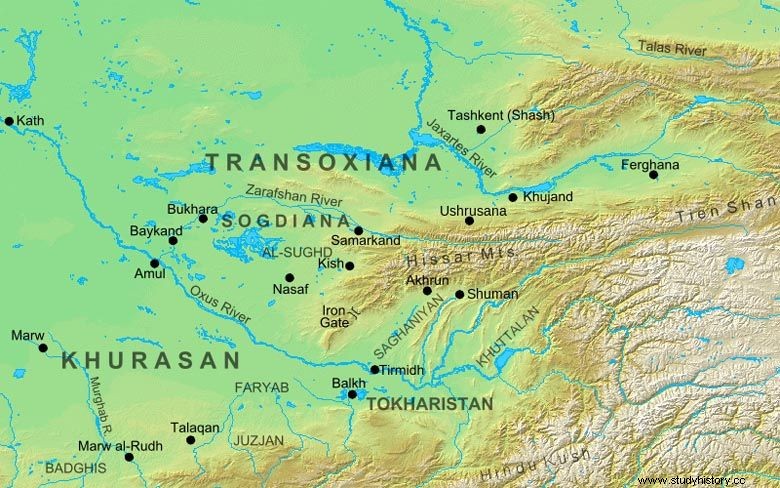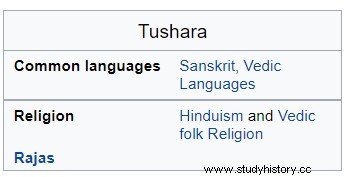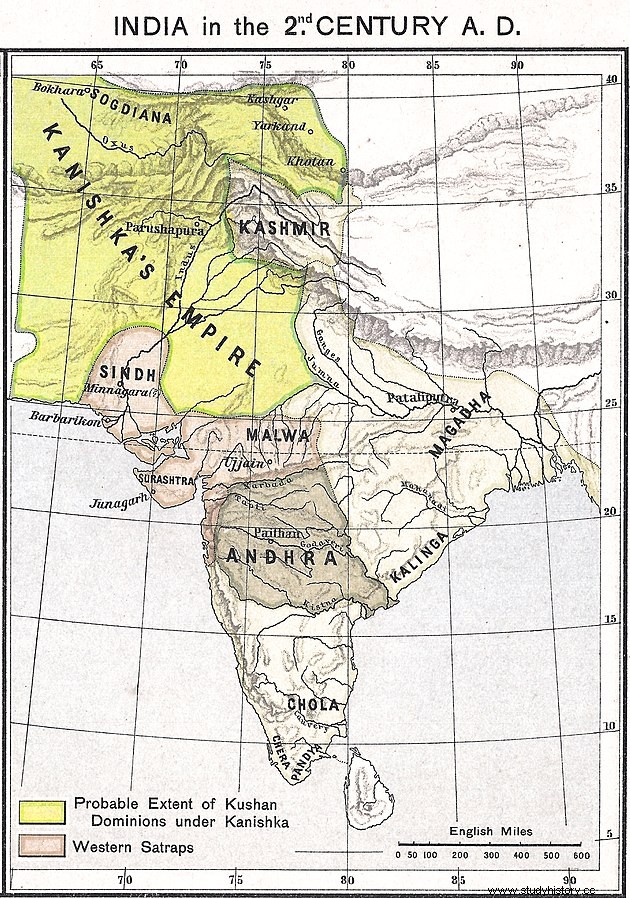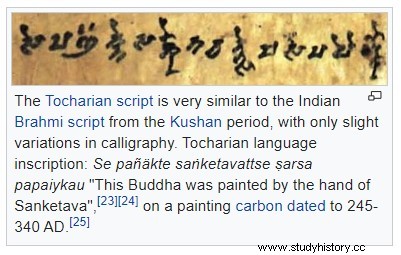In the previous article "The Kushans of Central Asia were Hindus", you have seen that almost all historians agree that the Yuchi of China are the Rishik people mentioned in the Indian texts and the Shaivite Hindus were the people of the Kushan Yuchi clan. Most historians agreed that the Kushanas and Tukhars were one and the same people. In Chinese history, one of these has been called Mahayuchi and the other is called Small Yuchi. Greek historians write that the Tushars established the Kushan Empire by occupying the Greco-Bactrian kingdom, while according to Chinese history, a tribe of Yuchis was established by the Kushanas by the Kushans who took control of the Greco-Bactrian kingdom. Even the Blights and the Kushanas are found together between the Oxus River and the Jaxartes River, and also in the Tarim Uttaka (Xinjiang).
Whereas some historians like Rahul Sankrityayan, who wrote 'History of Central Asia' consider the Yuchis to be a branch of the Shakas and use the Yuchi Sakas for the Kushanas. Aurel Stein considers Tukhar (Tokharoi) to be a branch of the Yuchis. P. C. Bagchi believes that Yuchi, Tukhar and Tushar were the same people. According to some historians Kushan Kamboja also proves.
In fact, there was so much similarity in ancient civilization, culture, religion, tradition, language, dress of the whole of Central Asia and Tarim Utayak (Xinjiang) that historians, archaeologists who write the history of Central Asia feel that all were the same or they were like him. And he was like him etc. The history of human settlement is not only for a few thousand years, nor is the creation of the universe according to Christian belief only before 4004 BC.
Therefore, when we start the study of the settlement of a large area from any one point of thousands of years in the chronology of history, then there will be confusion. The oldest history of civilization is preserved in Indian texts, which does not fit into the Christian belief of Western historians, therefore rejecting it as mythology. Agenda The left-wing historians of India who write history also like this for their agenda, so they keep spreading the agenda in the name of history by telling it the supernatural knowledge of English historians.
Take doubts for example. These start telling the history of the Shakas from the second to third century AD. Where were all these before that? The whole of Central Asia was to be known as Shakadvipa, why? The doubts were spread from modern Russia to India, how? Only the ancient texts of India have the answer to these questions and I have given a glimpse of it in my previous article “The Sakas of Central Asia were the Suryavanshi Kshatriyas of India”. In this article, we are writing briefly the Hindu history of the frosts described in Indian texts.
Ancient Central Asia was an extension of India
Central Asia and ancient India have long traditions of socio-cultural, religious, political and economic contact since ancient times. [Alberuni's India, 2001, p 19-21, Edward C. Sachau – History; Dates of the Buddha, 1987, p 126, Shriram Sathe; etc.]
In 3000-4000 BC, a culture is found in Khvarazm, which Soviet historians have named the Keltminar culture after the Keltminar canal that runs north from the Vaksh river here. To the north of this abandoned canal at Kizilkum lies the ruins of Jabaskalan. Comparing with archaeological objects, Soviet archaeologists have come to the conclusion that the culture that existed here at that time was of the same type from the Southern Urals, Syr Darya, East Turkestan to the coast of the South Indian Ocean. The culture was there. They spoke Uyghur mixed Indian language. (History of Central Asia - pages 158-159)
There is ample indication that Vedic civilization, culture, religion and language were in operation throughout Central Asia and the Tarim Basin, with local changes, before the Iranian Hkhamanis conquered Central Asia in the 7th century BC. The second largest cultural invasion into Central Asia was by the Greeks in the 4th century BCE, and thirdly, the ancestors of the Buddhist converts in Central Asia and Tarim Upayak (Xinjiang) were Hindus. Historian PN Oak writes that the words 'Turkish Hindu' for Turks of Central Asia are found in ancient Arabic texts.
Now pay attention to the following three paragraphs:
According to Grierson (Central Asia) the people of the Media were Aryans and were here in 2500 BC. Aryans were dominant in the media. Their gods were those whose names we find later in India and that they were Satem speakers, which is more closely related to ancient Sanskrit.
Commenting on the people of the Media, Will Durrau writes, "We do not know the origin of who the people of the Media were. We find the first mention of them on a plaque recorded in the campaign of Shalmanejar III in the hills of Kurdistan at a place called Parshua. This suggests that twenty-seven chieftains ruled the region, sparsely populated by people called Ahmadai, Madai or Midi (people of the Midiya). Were." (Our Oriental Heritage, New York, Writer-Will Durant, Page-350)
At the time of Xuanzang, the Tukhar country was divided into twenty-seven administrative units, each with its own chieftain There were. [On Yuan Chwang's Travels in India, Edition:1904, pp. 102, 327.]
From the above three paragraphs it does not seem that the Vedic Aryans of Media being talked about must have been Tukhar people or their ancestors? Well, let's move on.
Ancient Hindu History of Tushars

Except Kanishka, all the other Kushan Shaivites were Hindus. Being a Hindu, he also respected and patronized Greek, Zoroastrian and Buddhism. You will be surprised to know that the entire history of frost is also the history of Hindus who follow Indian culture and religion and speak Indian language.
According to Mahabharata (1:85) Tushar was a descendant of Anu, son of Yayati. Maharaja Yayati had made his successor as his junior son Puru who ruled the kingdoms of Kuru and Panchala. In the other four, the Yadus established the Yuduvanshi kingdom in the middle and west of India, while others established their own kingdoms in the border areas of India. Anu's descendants later migrated to Iran.
According to Vayu Purana, the state of Madra was founded by Shibi, son of Ushinara, who was a descendant of Anu, son of Yayati. According to the Bhagavata Purana, the state of Madra was established by Madra, who was the son of Shibi, a descendant of Yayati's son Anu, in Tretayuga. That is, the state of Madra was established by Ushinara son Shibi and named after his son Madra or Shibi son Madra himself established the state of Madra.
But according to the Mahabharata, both Salva and Madra were twin kingdoms, their ancestors were also the same. These were the descendants of Vyushitasva, a descendant of Maharaj Puru. He performed the Ashwamedha Yagya and expanded his empire in the east, west, north, south. He had seven sons, out of which three became the kings of Salva and four became the kings of Madra.
From both the above descriptions, it is concluded that the kingdom of Madra was established by the descendants of Anu, son of Yayati (since the mythological history is more ancient) but later the descendants of Yayati's son Puru took over it. He expanded the state of Madra in all four directions by conquering Digvijay and divided the state of Madra into Uttar Madra (Midiya), Dakshin Madra, West and East Madra and ruled by four Puruvanshi kings.
The discussion of Uttar Madra (Midiya) and Dakshin Madra is found in almost all historical texts. Paschim Madra has been discussed by Panini in his book. The Salva kingdom was probably located in the west adjacent to Madra, which was subjugated by Madra. It is possible that the descendants of the defeated Anu may have left for Iran at this time as mentioned in the above Mahabharata.
But, there is no information of any settlement of frosts in Iran. That's why it seems that they soon came back and settled on both sides of the river Vaksh. It is possible that after the death of King Shalya (king of Uttarmadra and Salva) in the Mahabharata war, the Tushars, who settled on both sides of the Vaksh river, recaptured Midiya, and from 2500 BC to AD, whenever they were in power, there were twenty-seven chieftains. Must have been doing the work of administration through the medium. It is known that the universal period of Mahabharata war is considered to be 3136 BC.
According to Vayu Purana and Matsya Purana, the river Oxus used to flow through the kingdoms of Tusharas, Lampkas, Pahlavas, Pardas and Shakas etc. (Vayu Purana-1.58.78-83). Various historians are of the opinion that the Tukhars were the neighbors of the Paramakambos, who settled in the north of the Hindukush, who were settled on the banks of the river Vaksh.
In the Mahabharata, Banabhatta's Harshacharita and Kavyamimamsa, there is also a mention of a Tusharagiri. Some historians are of the opinion that the present Hindukush mountain may be historical frost. Tushar also came to India along with the Kushanas. Varahamihira's Brihatsamhita also mentions the settlement of frosts in Bharuch and Barbaricum of the Indus Valley [Brihatsamhita XVI.6].
Tushars are described as Kshatriya in Indian texts
In Mahabharata, Kambojas, Tusharas, Shakas, Yavanas, Pahlavas, (Vrishnivanshi) Harhuns etc. have been described as Kshatriyas but due to not following the Vedic rules properly they gradually became Mlechcha (Mahabharata:12:35). It has also been claimed in Manusmriti that Kamboja, Shaka, Yavana, Parada, Pahlava etc.
But the Rishik castes are said to be the descendants of the sages and we have not yet found the use of the word Mlechha for them in any Indian text. Therefore, there is a possibility of separation from the 'root root' even if the Tusharas and Rishikas (Kushans) appear to be culturally, religiously, linguistically and even spatially.
Role of Blight in Mahabharata War
In the battle of Mahabharata, under the leadership of King Sudakshina of Shaka, Tukhar and Yavana Kamboja fought on the side of Kauravas against Pandavas [MBH 6.66.17-21; MBH 8.88.17]. One reason for the Kambojas to fight on the side of the Kauravas can also be that Duryodhana's wife was Kamboja. In Karnaparva, Tushars are described as fierce and dangerous warriors.
F. E Pargiter writes that "the Tusharas, along with the Yavanas, Shakas, Khasas and Daradas had collectively joined the Kamboja army of Sudakshina Kamboj and had fought in Kurukshetra war under the latter's supreme command. [The Nations of India at the Battle Between the Pandavas and Kauravas, Journal of the Royal Asiatic Society of Great Britain and Ireland, 1908, pp 313, 331, Dr F. E. Pargiter.]
Tushar was a Hindu even after BC
Below is a screenshot taken from Wikipedia Tushara. They have written Sanskrit and Vedic language in the language of the frosts and Hindu and Vedic religion are written by the religion of the frosts.

Rishik and Tusshar

In the context of Arjuna's Digvijay in the Mahabharata, Kamboja is mentioned along with Loha (Lohan) and Rishika Janpadas (Sabha. 27, 25). According to the Sabha Parva of Mahabharata, Rishik castes along with Lohan, Parama Kamboja helped in the conquest of the kingdoms of Uttarapatha during Arjuna's Digvijaya.
But the people who came to participate in Yudhishthira's Rajasuya Yagya in the Sabhaparva of Mahabharata were- Tukhar, Bahlik, Kirat, Pahlava, Parada, Darad, Kamboja, Saka, Kanka, Romaka, Yavana, Trigarta, Ksudrak, Malava, Anga, Vang, Vrishnivanshi Harhuna, China, Sindhi, Munda, Tung, Kekay, Kashmiri etc. (Mahabharata:2.51-2.53; 3.51)
The above visitors do not belong to Rishik caste. Therefore, despite the analysis of all the facts and evidence, doubts remain as to why the Rishis who helped Arjuna in conquering the kingdoms of Uttarapatha did not participate in the Rajasuya Yagya and if they did, they were not Tukhars at all?
Flights of the Tarim Valley (Xinjiang)
Central Asia writer Rahul Sankrityayan writes, “Chinese traveler Changqian before 124 AD finds the Yuchi Shakas (Kushans) to be the masters of the Vakshuvayaka. Bactria was later named Tukharistan because of the frosts. The Yuchi were originally Saka languages. Their language was related to Irani, Sanskrit and the old Saka language Satem family (ancient Sanskrit)."
He further writes, “In the first century AD, the Indian script and Indian language were used in the southern part of the Tarim valley at that time. It is known from the name etc. that the people who settled from India had priority there. The Tushars resided in the northern part of the Tarim Utayaka. Although there was a difference of north-south in language, caste and customs, yet….both regions were the followers of the same religion and culture.”
Discoveries in the early twentieth century found two new Indo-European manuscripts in the Tarim Basin that were easier to read because they were in the Indo-Brahmi script. The author is of the opinion that their ancestors were one and their vocabulary was also similar. A Buddhist text is found in Old Turkic (Uighur) language which was translated into Tochari language before Sanskrit [ Beckwith (2009), pp. 380-381].

Tochari (Tushar) used to assume the title of King Devputra. The kings of Kucha called themselves Devputras just as the Kushanas called themselves Devputras [Aryan Books International. p. 133]. A large number of Tukhars of Tarim Upatyaka had embraced Buddhism. बौद्ध धर्म अपनाने से पहले वे किस धर्म को मानते थे इसकी पर्याप्त जानकारी नहीं मिलती है पर वे सूर्य देवता, उषा देवी और सोम (चन्द्रमा) की पूजा करते थे [Snow, J.T. (June 2002), “The Spider’s Web. Goddesses of Light and Loom].
जब चीनी महंत जुआनजैंग ६३० ईस्वी में कूचा पहुंचा तो सुवर्णपुष्प का पुत्र और उत्तराधिकारी राजा सुवर्णदेव ने उसका स्वागत किया जो हीनयान बौद्ध धर्म का अनुयायी था. जुआनजैंग ने यह भी बताया की उनके सिद्धांत और नियम वही थे जो भारत में थे और जो उन्हें पढ़ते थे वे ठीक भारतियों की तरह पढ़ते थे. [Grousset, René (1970). The Empire of the Steppes:A History of Central Asia]
